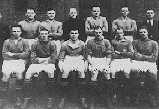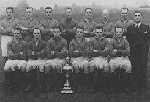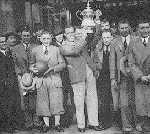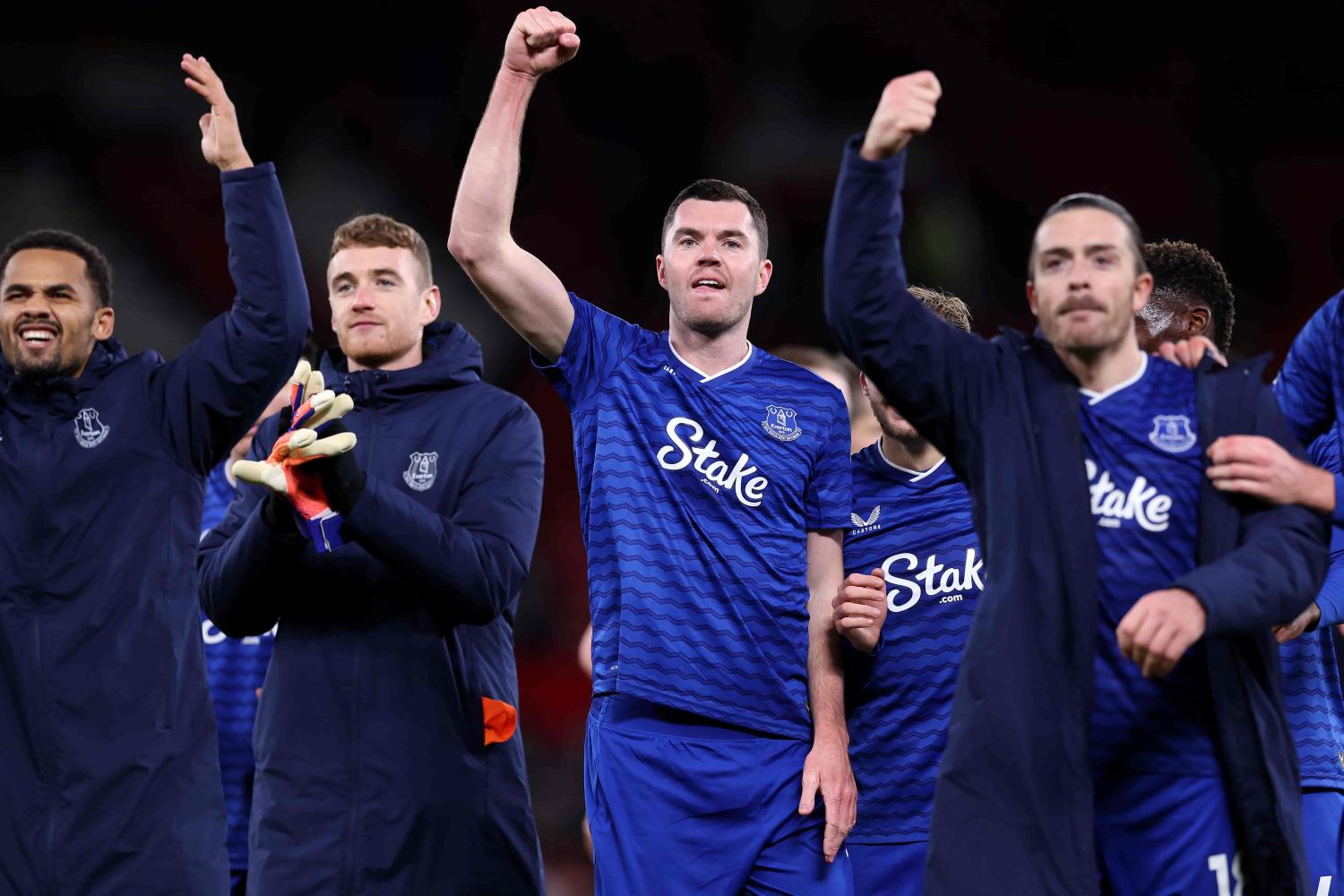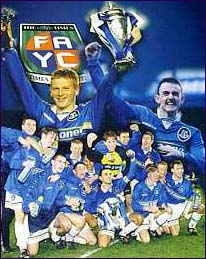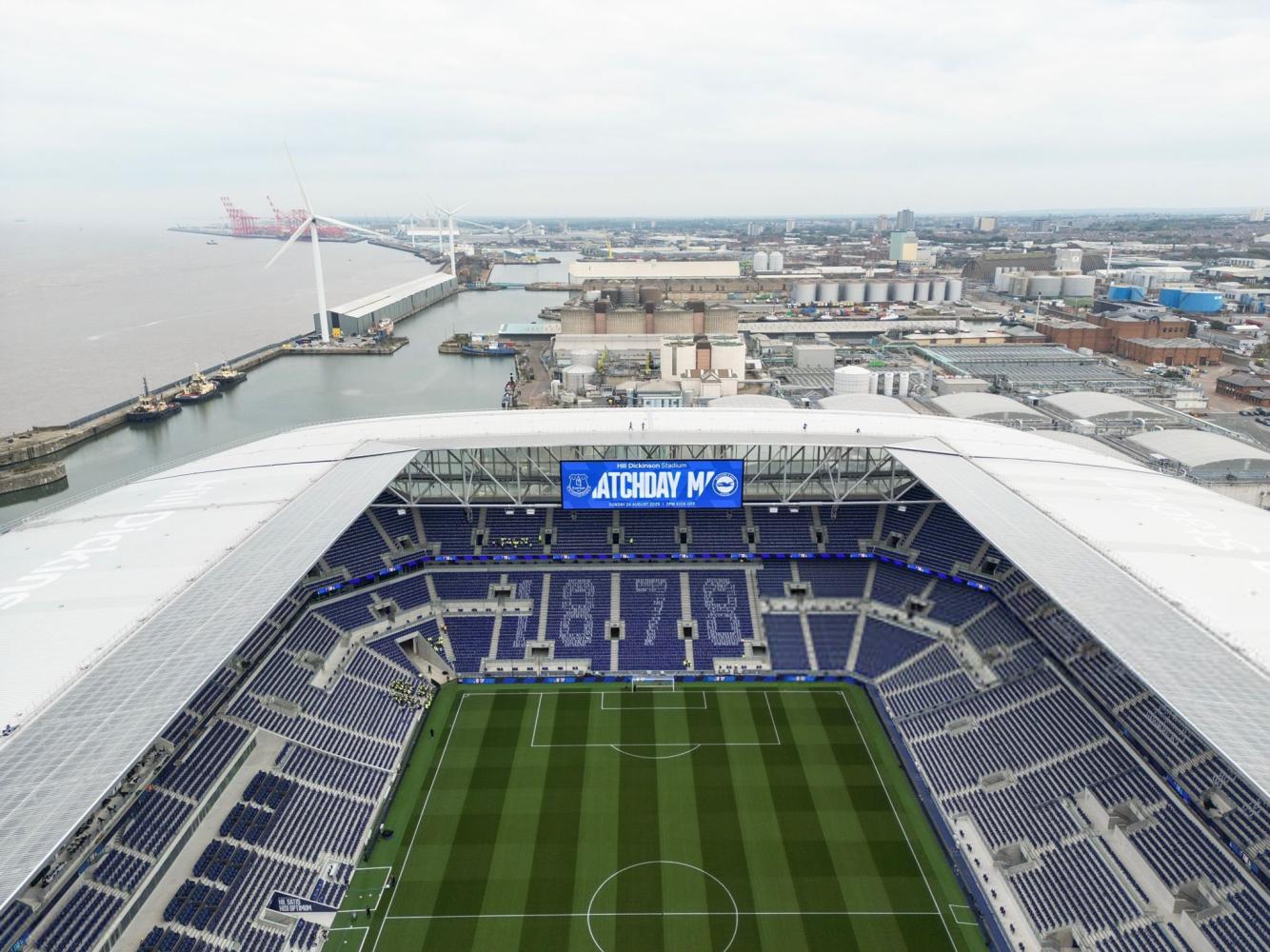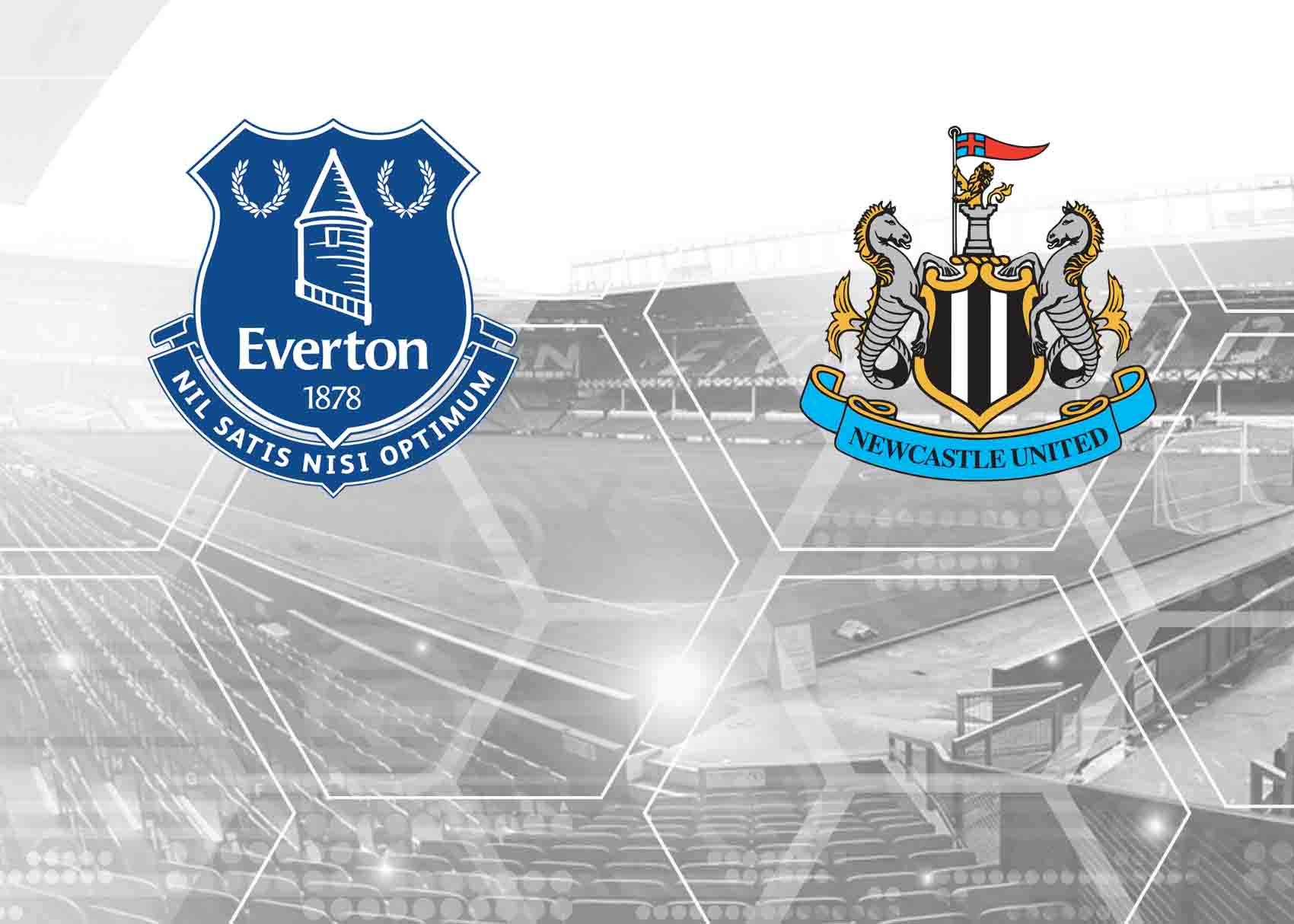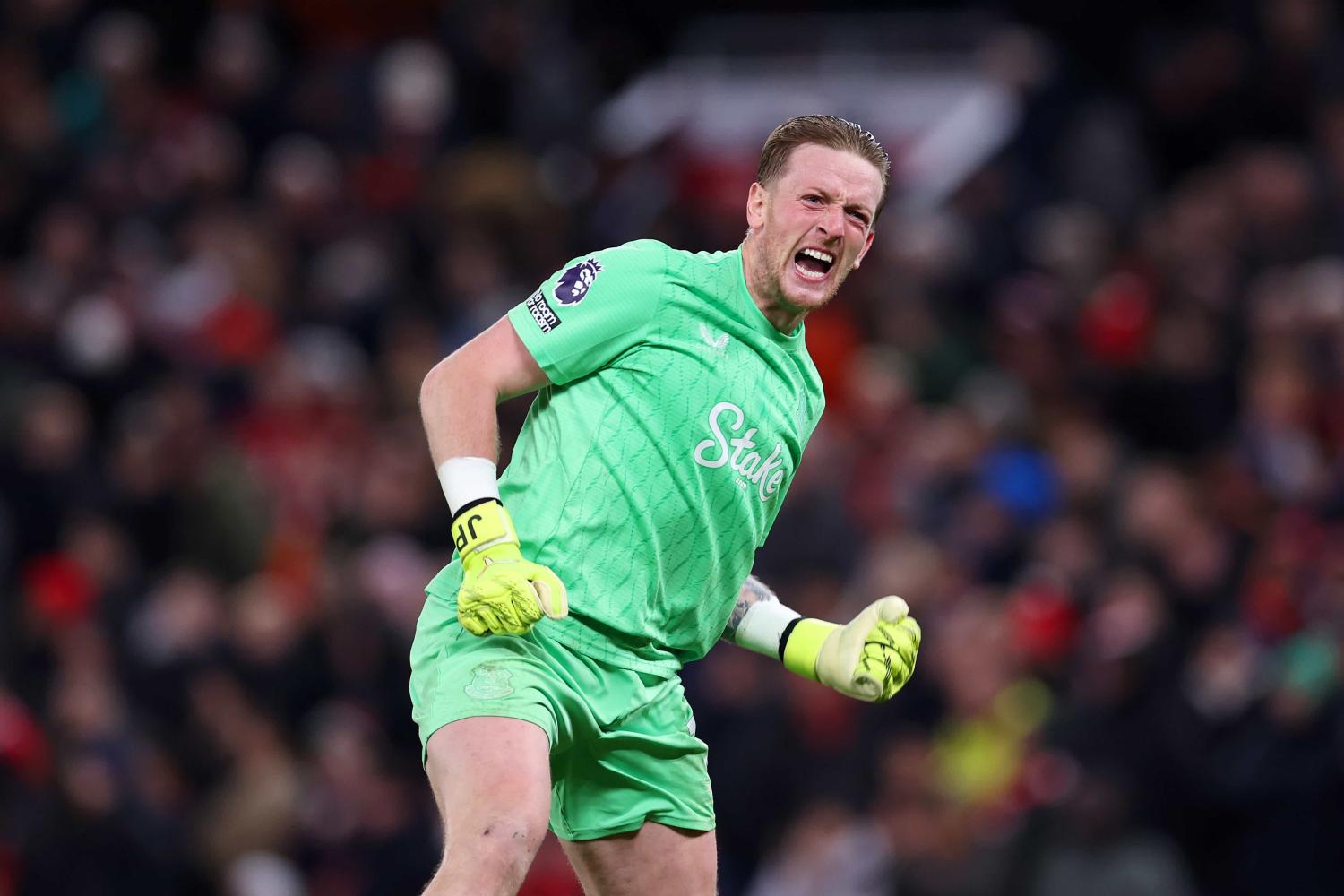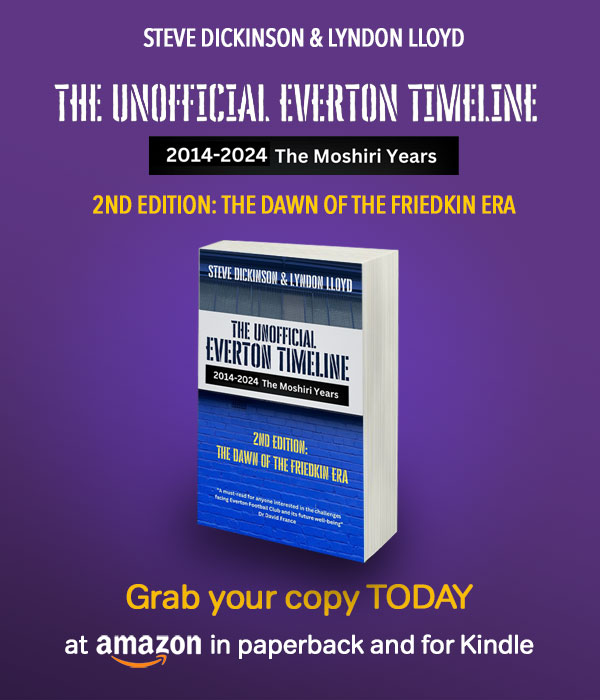III: BETWEEN THE WARS (1915-39) |
DIXIE DEAN'S ERA
The years after World War I were not good for Everton in terms of silverware, although the press said Everton played entertaining football. The crowds were especially entertained by the old winger Sam Chedgzoy, the dribbling wizard Bobby Irvine, and overhead-kick specialist Dicky Downs, who was also known for his flexibility. It is said, that Downs invented the sliding tackle. Neil McBain, who played a few years as a centre-half, also did his share of entertaining, as he was a very elegant and skillful player who made surging runs forward, even at the expense of his defensive duties. In 1947, as manager of Third Division New Brighton, McBain found he didn't have a keeper for one match, so he went in goal himself, at the age of 52 years and 4 months, and is therefore the oldest player to have played in the League (New Brighton lost 0-3).
AN ETERNAL RECORD
Dixie Dean led Everton to the title in 1927-28 almost single-handedly, scoring an amazing 60 goals in that season, a record that still stands today and which may never be equaled. Dixie needed to score a hat-trick in the last game of the season against Arsenal to break the 59 goal record set by George Camsell the previous year for Second Division Middlesbrough. Dixie scored twice in the opening ten minutes, the second from a penalty. But scoring the record-breaking third goal wasn't so easy, even though the 60,000 fans cheered fanatically and the other Everton players tried to create openings for Dixie from every possible angle. Finally, with 8 minutes left on the clock, Everton got a corner-kick, and Alec Troup, who had created most of the goals Dean scored that season, went forward to take it. Troup crossed the ball in and Dixie Dean rose majestically above the defence to head the ball into the net. "The cheer was heard all the way to Aintree" – that is how the noise which followed has been described. The emotions at Goodison were indescribable. Even the Arsenal players greeted the hero and an equaliser from Arsenal at the end of the match did nothing to quell the fans' exuberance. Calculating all the goals, including Cup-ties and English team matches, the "super forward" scored 82 goals in 1927-28; and if we add the charity and training matches, the total is a fabulous 100 goals! Although Dean was virtually unbeatable in the air – many say he was the best ever -- he also knew how to shoot: he scored 40 of the league goals with his feet, so he "only" scored 20 with headers. An interesting fact is that Dean scored 31 goals in 15 away matches and 29 in 14 home matches. Dean scored a total of 349 goals for Everton in 399 matches and 16 goals for England in 18 matches. There are several reasons why Dixie Dean achieved these almost superhuman feats. First of all, Dixie was unbeatable in the air, rising above the defenders to head the ball in the net either with great force or with perfect accuracy into the corners of the goal. He was also able to shoot very effectively with either foot. Thirdly, Dixie Dean's attitude was very good, he brimmed with confidence, never moaned to the refs, and his jokes helped raise the spirit in the team. Dixie was the captain and spiritual leader of the team.
Why then didn't Everton win any trophies at this time? Dixie's playing style
lead to a lot of injuries, and in several seasons he barely played 25 matches.
Despite this, he usually scored more than a goal a game. THE UNTHINKABLE COLLAPSE, AND A NEW CHAMPIONSHIPAlong with Dean and Troup, Everton had other stars in the 1927-28 team. One of them was winger Ted Critchley who, like Troup, laid the ball off well for Dean. The other one was Warney Cresswell, a stylish English fullback, who made "modern" runs forward and usually stole the ball from the opposition with skillful rather than crude tackling. Also worthy of mention is Hunter Hart, who had a long career with the Toffees.
Everton's and Dean's fantastic season was followed by an incomprehensible collapse and, for the first time in their history, Everton were relegated to the Second Division in 1929-30. In Spring 1931 they went back up to the elite as the winners of the Second Division with 128 goals (an Everton record). The next season Everton won their fourth championship; this was only the second time in the League that a promoted team had won the First Division title at the first time of asking. The heroes included, along with Dean (45 goals), Critchley and Cresswell, the fine goalkeeper Ted Sagar, who would stay with Everton for a record 24 years. Sagar also had the record number of League appearances for Everton, 463 matches, before Southall surpassed this total. (The FA Cup Final of 1995 was Neville Southall's 650th appearance for Everton.) Sagar's total would have been a lot larger, but war interrupted his career. This Championship title wasn't the end of Everton's success between the wars, though. THE TOUGH SCOTTISH TRIO
There were other good players in the 1931-32 team apart from Billy Dean, Ted Critchley, Ted Sagar and Warney Cresswell: the tough left-half Jock Thomson who was still playing when the next championship came; inside-right international player Jimmy Dunn; the hard-shooting winger Jimmy Stein -- all three of them Scots – and the very technical inside-left Tommy "Tosh" Johnson. Everton, fired up after their relegation, extended their success in the following season by playing their first ever FA Cup final at Wembley in 1933 against Manchester City.
Before Everton got to the new footballing shrine, they had great difficulties
in beating the Second Division team West Ham in the semifinals at Wolverhampton's
Molineaux Ground. They finally won 2-1 (but what happened 47 years later!).
The winner was scored by Ted Critchley from a goalmouth scramble, but he
had to step down for the final to be replaced by Albert Geldard. THE SECOND CUP VICTORY
The final was all Everton and the Blues won the cup for the second time after beating City 3-0 with goals from Stein, Dean and Dunn. Everton were playing in white, because as both teams' colours were blue, the FA let the teams select between white and red, and City, who were allowed to choose first, chose red, to the relief of the Toffees. Everton's team in the final was: Ted Sagar; Billy Cook, Warney Cresswell; Cliff Britton, Tommy White, Jock Thomson; Albert Geldard, Jimmy Dunn, Billy Dean, Tommy Johnson, Jimmy Stein. In the '33 final, the players were numbered for the first time. Everton wore 1 to 11 and City 12 through 22. Dean's goal was a memorable one. Cliff Britton – one of the new stars -- had a throw-in, got the ball back, shimmied his way past a defender with a deft move, and then sent an "impossible" cross over the City keeper, which Dean headed into the goal with the back of his head, almost smashing against the post in the process, a la Andy Gray!
The same carriage was reserved for the Everton team at Lime Street as was used to carry the victorious 1906 cup team. A crowd of half a million people cheered the team when they arrived. These achievements were followed by a few more modest seasons while Arsenal dominated the First Division. The spectators were still entertained by both the Everton wingers, Albert Geldard and Jackie Coulter, and by the very talented Cliff Britton. Geldard and Britton had been part of the '33 team cup winning team. Geldard was a real wizard, both on and off the pitch. His hobbies included magic tricks and he was one of the trickiest right wingers ever seen: he was devastatingly fast and he had a trick-bag that seemingly never ran out. Geldard made his debut with Bradford at the tender age of 15 years and 156 days, making him the youngest player in the League. So Everton have had both the youngest and oldest players (Neil McBain) on their books. Coulter was a real entertainer, because he used to tease the fullbacks before going past them. What a pity that a broken leg cut short his career. Britton was one of the classiest playmakers of his era, a man who could produce miracles with short or long passes.
All of the above took part in the "cup-tie of the century", when Everton
beat Sunderland 6-4 in the Fourth Round of the FA Cup at Goodison in January
1935. This match was even more intriguing than the 4-4 match against Liverpool
56 years later. It was decided with just minutes remaining in extra time,
when Geldard scored twice to the delight of the 56,000 spectators. The most
puzzling thing about the match was that, even though Everton scored six times,
Dean didn't score a single goal! THE GLORIOUS CHAMPIONSHIP TEAM OF 1938-39
A new superteam was in the making, and it bloomed in 1938-39, the last season before the war. The war forced the League into yet another long break. This time the title stayed at Goodison for eight years, before it was handed over, again, to the other side of Stanley Park. Everton had bought in 17-year old Tommy Lawton from Burnley in the spring of 1937 for 6,500 pounds. With the guidance of Billy Dean, who was at the end of his career, he rapidly developed into a great forward. No-one else could have been able to fill Dean's boots. At Everton, Lawton was greeted almost as a gift from God, because Dixie's retirement was the worst fear in the minds of the board. During the championship season, the 19-year old Lawton scored 34 goals and was instantly selected for the England team. When choosing the best center-forwards of all time, Everton have two players that lead the pack: Dean and Lawton. Dean was a better goalscorer, but Lawton was a better all-rounder. Born October 6, 1919, Lawton was also an excellent goalscorer: he scored a total of 570 goals in three years for his school team!
Chairman Will Cuff managed to get Lawton by promising that he would be playing
in the England team before his twentieth birthday if he joined Everton -
and that's exactly what he did! In February 1937, against Tottenham in a
cup replay, Lawton scored a goal that was just like the ones Dean used to
score. Seeing this, Dean said: "This is it. This is the end." Tommy Lawton
had arrived. LEGENDS AND VIRTUOSOS
The 1938-39 team had several other stars. A player who reached the heights of Lawton was Joe Mercer, the midfield maestro, who rose to the England team. Mercer is one of the most legendary players of the English game. Mercer, who played at left-half, had vision and skill second to none. Mercer joined Everton as a junior. During World War II, Mercer, Cliff Britton and Wolverhampton's Stan Cullis formed one of the best midfield trios the England team has ever had. Other Goodison heroes included fullback Norman Greenhalgh, who Sir Stanley Matthews considered as his toughest opponent, and centre-half and Welsh international Tommy G Jones, known as "TG" Jones, Despite his position, he had magnificent skill. Inside-left was Alex Stevenson, a virtuoso with the ball. On the wing were the great dribbler Wally Boyes – a tiny player who played in the England team and was a great entertainer – and Scottish international Torry Gillick. Just as with Jackie Coultier, Stevenson combined with Boyes to form the best left side in the country. The keeper was still, of course, Ted Sagar, who became one of the greatest Everton keepers, and whom only Neville Southall can beat when seeking to nominate the best-ever Everton keeper.
Everton were one of the last league teams to appoint a manager, in 1939. Before this, the team selection was made by coaches and boardroom members. Theo Kelly, better known for his administrative skills, was appointed as the first manager. He was succeeded by Cliff Britton – the ex-star player -- Ian Buchan, Johnny Carey, Harry Catterick, Billy Bingham, Gordon Lee, Howard Kendall, Colin Harvey, Kendall again, Mike Walker (just 10 months, the shortest time for any Everton manager) and now Joe Royle. |
| « Everton Before WWI | The Bad Decades » |
|
|
||
| F I II III IV V VI VII VIII IX X B | Between the Wars |



